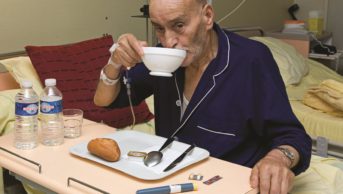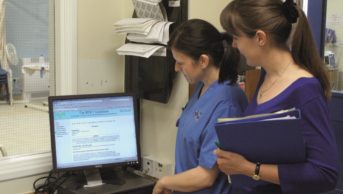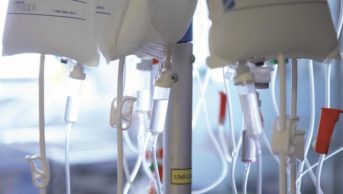The rectum and vagina are relatively uncommon routes for drug administration. However, they can be ideal sites for drug delivery when it comes to certain diseases and patient groups.
The rectal route, for example, can be useful in paediatric and geriatric groups, and in patients who are unable to take oral medicines due to nausea, vomiting or unconsciousness. This route can also be useful for delivering drugs to prevent pre- and post-operative systemic infections.
The rectal and vaginal routes belong to the transmucosal routes of drug delivery and thus offer the advantage of bypassing first-pass metabolism. They can be used either for local or systemic drug delivery.
Developments on rectal dosage forms
With the rectal mucosa allowing quick drug absorption and the rich rectal vasculature enabling easy uptake to systemic circulation, drug serum levels can be comparable to those of the oral and parenteral routes. For example, diazepam absorption from Stesolid rectal tubes, an enema formulation, is 100 per cent.1
However, drug delivery via the rectal cavity can be challenged by erratic drug absorption due to potential expulsion of the dosage form and low adhesion to the rectal membrane. In addition, drug bioavailability is affected by the site of drug absorption within the rectal cavity. The superior rectal veins go via the liver whereas the inferior rectal veins bypass liver metabolism, thus correct positioning of the dosage form, at the lower rectum, is crucial.
Rectal dosage forms currently on the market are designed as immediate drug release formulations (suppositories, enemas, foams, suspension, ointments) intended to have local or systemic effect for the management of a range of conditions (eg, constipation, haemorrhoids, local and systemic analgesia, management of central nervous system disorders and the treatment of local or systemic infections). Research and development on rectal drug delivery focuses on two areas: the enhancement of patient compliance and the design of mucoadhesive formulations that can provide better control of the dosage form’s positioning in the rectal cavity.
For example, Penlan Healthcare has used the Aragel and Valiant technologies for the design of mucoadhesive gels and dry compressed mucoadhesive tablets containing analgesics, local anaesthetics, antibacterials, antifungals, anti-inflammatories and steroids. It is expected that these technologies will enhance dosage form positioning, thus drug bioavailability from the rectum.
Thermoreversible rectal gels
Liquid formulations that turn to gel once inserted into the rectum can allow easier administration and positioning than conventional suppositories and can prevent dosage form leakage, which is common with rectal suspensions and enemas. They are formulated as a polymer solution consisting of thermoreversible polymers (eg, poloxamers, in combination with mucoadhesive polymers that enable gel attachment to the rectal mucosa). These in situ thermoreversible liquid-gel formulations, also called thermoreversible “liquid suppositories”, are liquid at low temperatures (<10C) and turn to gel at body temperature.
The design of liquid suppositories using lipophilic actives (eg, non-steroidal anti-inflammatory drugs) requires the incorporation of an appropriate solubility enhancer in the formulation. For example, pharmacokinetic studies on flurbiprofen liquid suppositories made of poloxamer (thermoreversible polymer), sodium alginate (mucoadhesive polymer) and hydroxypropyl-beta-cyclodextrin (solubility enhancer), showed comparable bioavailability to a commercial intravenous flurbiprofen formulation.2
Developments on vaginal dosage forms
Other than contraception, labour induction, treatment of vaginal infections and local menopausal symptoms, the vaginal route is a relatively unexploited site. There is potential for the vaginal route to be exploited for a diverse therapeutic portfolio, including vaccine delivery and chemotherapy. The large surface area and blood supply of the vaginal epithelium can allow easy systemic drug delivery. However, dosage form retention can be problematic due to clearance by the vaginal fluids. In recent years novel mucoadhesive vaginal formulations have been investigated as chemotherapeutic systems (eg, for the treatment of cervical neoplasias).3
Another recent focus is the design of controlled release vaginal formulations for the prophylaxis against AIDS and other sexually transmitted infections. The development of several vaginal drug delivery platforms is mainly driven by the need to increase choice and thus compliance by the wider female population.4
Vaginal rings
Vaginal rings, also called intravaginal rings (IVRs), are polymeric ring-shaped dosage forms originally designed as contraceptive devices and for hormone replacement therapy (HRT) in the 1970s. The rings are made from elastomeric polymers and offer extended drug delivery. For example, Estring is a silicone ring releasing estradiol hemihydrate over a three-month period and is intended for the management of HRT.
In recent years IVRs have witnessed a surge of new interest as promising microbicide delivery systems for the prophylaxis against HIV and other STIs. The International Partnership for Microbicides has formulated a potent antiretroviral drug, dapivirine, into a silicone vaginal ring that is designed to provide sustained release of dapivirine over 28 days. Recent phase I and II clinical trials compared dapivirine ring with a placebo ring among 280 women.5 The encouraging results, alongside similar trials confirming the safety of the ring among women in Europe, have led to the launch of a large-scale phase III trial that will involve 1,650 women and will examine the efficacy of dapivirine vaginal ring. The results of this trial are due in 2015.6
Another innovation is the design of IVRs containing a combination of drugs. For example, NuvaRing is a contraceptive IVR containing etonogestrel and ethinyl estradiol in an ethylene vinylacetate co-polymer. However, the formulation of combination IVRs is not always straightforward. Diverse drug physicochemical properties or diverse drug release profiles may not lead to an effective formulation simply by mixing both drugs in a single polymer matrix, thus requiring the development of novel IVR designs. A multi-segment IVR has been formulated for the combination of two antiretrovirals (eg, hydrophilic tenofovir with hydrophobic dapivirine, where tenofovir is incorporated in a water-swellable polymeric segment and dapivirine into a lipophilic polymer).4
Multi-segment IVRs are promising systems that can be tailored to a wide range of active drugs, enabling optimum drug release rates from each segment. Other sophisticated designs involve the incorporation of drug-loaded tablet inserts within the polymeric ring.4
A vaginal ring containing a combination of two antiretroviral drugs, dapivirine and maraviroc, has recently entered phase I clinical trials.7 The two drugs have different modes of activity against the HIV virus, and it is hoped that the combination ring may offer greater protection against HIV in case the virus develops resistance towards either drug.
The need to provide simultaneous protection against AIDS and unplanned pregnancy, especially in developing countries, has driven research on the design of vaginal rings containing a combination of antiretroviral and contraceptive drugs. As explained, the formulation of such “dual-protection” rings can be challenging due to the diverse physicochemical properties and target doses of the active drugs.4
Silicone polymer is not biodegradable thus research on the development of vaginal rings made from biodegradable polymers, without compromising dosage form stability and performance, is under way to ensure environmentally friendly systems.4
Vaginal gels and pessaries
Thermoreversible gels, mucoadhesive hydrogels and pessaries have been studied as formulation platforms for the delivery of antiretroviral and antimicrobial compounds, labour-inducing hormones and even for intravaginal vaccine delivery.
A phase II clinical trial of a vaginal mucosal vaccine consisting of heat-inactivated uropathogenic bacterial strains in the form of pessary showed a reduction in the recurrence of Escherichia coli urinary tract infections.8
Clinical trials on female volunteers demonstrated greater immune response from a vaginal gel containing cholera vaccine than an orally administered cholera vaccine.9 It was concluded that immunity can be achieved via intravaginal vaccination.
Vaginal films
The need to increase patient acceptability for vaginal dosage forms has led to the development of patient-friendly vaginal formulations such as films. These are thin, small polymeric formulations that can be easily inserted into the vaginal cavity without an applicator and without causing discomfort. According to a study, women find vaginal films easier to apply than other types of vaginal formulations such as pessaries, foams and gels.10,11
Similar to other transmucosal polymeric films, vaginal films act as fast-dissolving formulations for immediate drug release. Films dissolve rapidly when in contact with the vaginal fluids and turn to a mucoadhesive viscous solution that attaches to the vaginal wall and gradually is washed out without requiring removal. For example, the vaginal contraceptive film from Apothecus Pharmaceutical Corporation contains a spermicide (nonoxynol-9) in a water soluble polymeric film.
Recent studies on vaginal films focus on the delivery of antiretroviral drugs. ImQuest Biosciences has formulated a new antiretroviral compound in a polyvinyl alcohol film that dissolves within 10 minutes while simultaneously releasing the active drug. The film is still at developmental stage.12
Conclusion
The rectum and vagina are the drug delivery routes of choice for a range of therapeutic indications. The design of new and improved formulations that allow easier insertion and retention in the vaginal and rectal cavities aims to increase patient choice, compliance and therefore therapeutic outcome.
About the author
Kalliopi Dodou is a senior lecturer in pharmaceutics in the Department of Pharmacy, University of Sunderland
References
- Stesolid rectal tubes. Available at: www.medicines.org.uk/EMC/ (accessed 12 July 2012).
- Kim J-K, Kim M-S, Park J-S et al. Thermo-reversible flurbiprofen liquid suppository with HP-b-CD as a solubility enhancer: improvement of rectal bioavailability. Journal of Inclusion Phenomena and Macrocyclic Chemistry 2009;64:265–72.
- Shaikh R, Raj Singh TR, Garland MJ et al. Mucoadhesive drug delivery systems. Journal of Pharmacy and BioAllied Sciences 2011;3:89–100.
- Kiser PF, Johnson TJ, Clark JT. State of the art in intravaginal ring technology for topical prophylaxis of HIV infection. AIDS 2012;14:62–77.
- First clinical trial among African women to test vaginal ring that prevents HIV transmission. Available at: www.news-medical.net/news (accessed 12 July 2012).
- Large-scale trial of vaginal ring that releases anti-HIV drug announced at health summit in London. Available at: www.news-medical.net/news (accessed 12 July 2012).
- First combination ARV vaginal ring for HIV prevention being tested in phase I safety trial. Available at: www.eurekalert.org (accessed 12 July 2012).
- Hopkins WJ, Elkahwaji LM, Leverson GE et al. Vaginal mucosal vaccine for recurrent urinary tract infections in women: results of a phase 2 clinical trial. Journal of Urology 2007;177:1349–53.
- Wassen L, Schon K, Holmgren J et al. Local intravaginal vaccination of the female genital tract. Scandinavian Journal of Immunology 1996;44:408–14.
- Elias C, Coggins C. Acceptability research on female-controlled barrier methods to prevent heterosexual transmission of HIV. Journal of Women’s Health and Gender-Based Medicine 2001;10:163–73.
- Rohan LC, Sassi AB. Vaginal drug delivery systems for HIV prevention. AAPS Journal 2009;11:78–87.
- Anti-HIV vaginal gel promising for protection in Africa, SE Asia. Available at: www.sciencedaily.com (accessed 12 July 2012).


